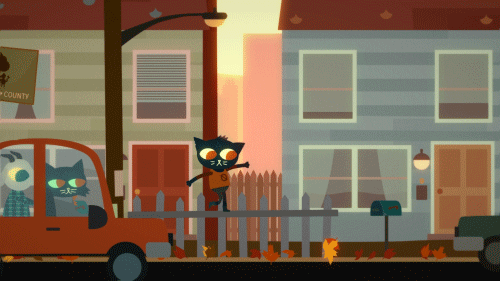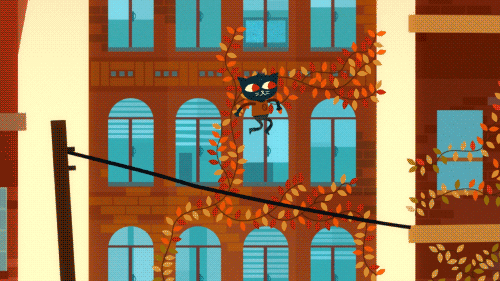Motion has been a core part of the video game experience since it’s inception. The fundamental joy of pressing a button and seeing something move on your screen underpins everything we’d call a video game. For some games, motion is at the very essence of the experience. I’d like to talk about games where motion is not at the core, and how they can benefit from it anyway.
Point-and-click adventure games, visual novels, and many RPG’s largely forsake motion in their gameplay, and often to their detriment. Hardcore fans of the genre may even take pride in the sparseness of action in these games, but just as many would-be players simply don’t have the patience to play a game where they never feel like they are moving–even if there is a deep and complex narrative world to explore, or a mentally stimulating gameplay mechanic to engage with.
In truth, for many players, exploration requires motion. Sailing a ship, hurtling through space, speeding down a highway, galloping along on a horse, soaring through the sky–these are mechanics often adopted by open world or otherwise exploration-oriented games to give a sense of space, and to capitalize on the joy of motion. And while most players will resort to fast traveling as soon as possible, I do remember a certain sense of freedom when, in Skyrim, I could afford a horse, and was ready to go anywhere I pleased, thus mounted.
This same principle can be applied to games that don’t have a huge open world to explore. Putting the sense of motion into exploration, and making the simple task of traveling from one place to another feel good, is something even a non-action, narrative-driven game can benefit from.

A Note on Terminology
Throughout this article, I use the term “motive controls” to mean a game control scheme where the player directly controls a character on-screen, which has some dynamic motion capabilities, such as running, jumping, or flying. I would use “motion controls,” but that sounds too much like a virtual-reality-like convergence of human body motion and character motion. I don’t want to address human body motion as a game control scheme here; just the motion of game characters on a screen.
Motion in Non-Action Games
My poster-child for good motive gameplay in a non-action game is Infinite Fall’s acclaimed Night in the Woods, a side-scrolling platformer-style game centered on an anthropomorphic (and highly relatable) cat named Mae Borowski, a college dropout who has just returned to her rural hometown. While there are a few simple platforming puzzles, fundamentally Night in the Woods is not a platformer. The core gameplay is all narrative: you could remove the platforming entirely, and have a coherent Night in the Woods adventure game; but if you removed all the narrative, what’s left is not a playable platformer. That said, Night in the Woods does make excellent use of platforming as a means of traveling and exploring.

It’s a game where you visit the same places every day–various locales around the protagonist’s hometown, places where old friends live or work–with no fast travel system. Yet, it doesn’t feel like a total drag because the basic act of traversing the areas is fun. The controls aren’t super tight, like they would be in an action-platformer, making certain sequences feel clunky, but the basic sense of kinesthetic joy the player gets jumping from rooftop to rooftop and tiptoeing across telephone wires is there.
Night in the Woods does a great job placing content in locations that make active use of motive controls a necessary part of your travel and exploration: jumping and climbing allows you to reach little tidbits like a crew of baby rats in a loft, or a friendly astronomy teacher on a rooftop who shows you constellations with a telescope. The platforming challenges to reach these nuggets of content are not difficult, but that’s actually a good thing. What’s important is putting players in a position where exploration involves analyzing their surroundings and engaging with their environment, rather than simply taking time to search every available pathway.
Perhaps the most impressive aspect of the platforming in Night in the Woods is how cleanly it meshes with the visual aesthetic. The game nails a storybook-like art style which neatly arranges each area in two dimensions for platforming, while still conveying a strong sense of depth to the environment. The way characters move on the screen works well for both jumping around, and dialogue-heavy scenes. The failing in this area is that it is occasionally difficult to tell what is a platform and what is part of the background or foreground. At heart, the game puts good visuals before platforming clarity, but since the platforming is never terribly difficult to begin with, this doesn’t cause major issues.

There are plenty of other games which try to get a little joy of motion in on the side. Persona 5, the newest entry in everyone’s favorite JRPG/dating sim fusion series, added stealth and platforming elements to dungeon exploration. When I first saw a trailer with the protagonist jumping across chandeliers and hiding from guards, I was pretty nervous. Persona is already, like, three games worth of mechanics rolled into one, and stealth-platforming is hard to get right when its the only gameplay. Turns out, my worries were largely unfounded. The high-motive gameplay in Persona 5 is pretty low-challenge: basically, press the X button, and something good will happen. The context-driven nature of the beast (it’s tricky to design stealth and platforming controls with only one button) made it occasionally awkward, but mostly it was just a way to make moving around your environment a little more interesting. The basic principle of this gameplay is not to add challenge, but allow the player to leap across chandeliers, dart out of hiding to ambush enemies, climb up and down multi-level areas, and look cool doing it. The additional learning curve this feature adds to an already dense game, plus a certain clunkiness that rears it’s head in certain sequences, puts the motive controls in Persona 5 at a solid B grade, but I will admit to having some fun with them once I was acclimated.
Walking simulators are a ripe genre for use of motive controls in non-action games, as designers increasingly explore the narrative and visual potential of first-person games without gratuitous shootouts. First-person controls can be deceptively tricky to nail, though, and when a developer takes the time to customize features like walking speed, head-bob, and running/jumping controls to their game rather than just plug-and-play with the cheapest first-person control script off the Unity asset store, it really shows.

What I really want to talk about, though, is not the minutia of head-bobbing, but clever usage of first-person motion in a narrative game. I’ll use The Stanley Parable as a familiar example. A game that is principally about choice, one might think The Stanley Parable would work well as a point-and-click adventure or visual novel, where discretized choices are the core interactive mechanic. However, The Stanley Parable gains enormous benefits from using motive controls. The game never features any sort of HUD-based interactivity: every choice in the complex, branching narrative is made via character motion, underscoring the player’s agency in the story, one of the primary narrative themes. The Stanley Parable also does a good job hiding choices in way that involve the player moving in atypical ways, such as jumping off a platform at a certain time, or turning around and finding that the door behind them now leads somewhere different. This organically forces the player to be alert and engage more actively with their surroundings.
The Stanley Parable also uses moving environments to effectively advance its narrative themes. At least twice in the game, the player finds themself on a moving platform: in one case, they’re being railroaded back towards the main path by an irked narrator, but have the option of leaping off to explore a different route; in the other, they’re on a conveyor belt in an industrial death trap, waiting to be crushed by unforgiving machinery. One situation emphasizes choice, the other is an embodiment of inevitability–two ideas that play tug-of-war throughout the entire game. The latter case shows off one of the most potent avenues opened by giving the player motive controls: what it feels like when you take them away.

So… High Motive Controls In Every Game?
Not necessarily. Pretty much every example of a non-action-oriented game with interesting motive controls comes with the caveat “it’s a little clunky at times, but…” Making sleek character controls that don’t feel or look clunky is hard. If you’re making a Metroidvania or bullet hell, smooth yet precise controls is, like, half the development process. (Metroidvania or bullet hell developers can correct me on that percentage). All games are made with time and budget constraints, so if jumping, flying, or driving isn’t a necessary part of a game, it might not make sense to spend time and effort on these features.
Also, a game shouldn’t include motive controls just for the sake of it. They have to synergize with other gameplay, whether that’s exploration or puzzles or how dialogue plays out or just reinforcing the visual aesthetic of the game. Replacing what would be a direct cut with a motive travel sequence really doesn’t add much by itself.
When done wrong, motive controls can be a dealbreaker for a player, adding boring or frustrating sequences which distract from the core mechanics. When done right, though, they can increase player engagement and create a sense of wonder and exploration that’s hard to match with just point-and-click.
-Louis